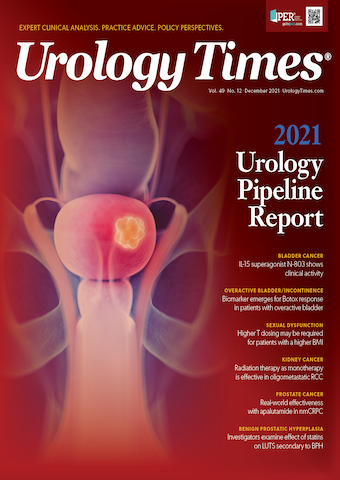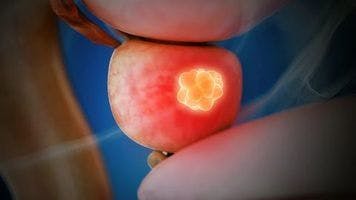Publication
Article
Urology Times Journal
PSMA/PET-derived risk stratification tool performs strongly in prostate cancer study
Author(s):
At the 2021 ASTRO Annual Meeting, researchers shared positive outcomes of a study exploring a nomogram designed to predict the probability of nodal and metastatic disease detected by PSMA PET/CT imaging in patients with newly diagnosed cN0M0 high-risk prostate cancer by conventional imaging.1
Ting Martin Ma, MD

Specifically, presenting author Ting Martin Ma, MD, said the nomogram was “significantly prognostic” of key clinical end points and achieved outcomes comparable to STAR-CAP and superior to other established risk-stratification tools.
“The model has an AUC of 0.75 and 90% of patients who had a nomogram-estimated risk below cutoff for overall upstaging could have been spared PSMA PET/CT as our model correctly predicted no upstaging. In other words, our model missed only about 10% of patients who would have benefited from PSMA-PET imaging,” said Ma, a resident physician in the Department of Radiation Oncology at UCLA.
Ma explained that there are several items factored into the nomogram, including a patient’s initial PSA, the percentage of positive cores on systematic biopsy, Gleason grade group, and cT stage. The nomogram combines these factors to calculate an estimate of nodal and distant-metastatic upstaging probabilities.
The study assessed the prognostic capability of the nomogram at predicting the following clinical outcomes: biochemical recurrence (BCR), distant metastasis (DM), prostate cancer–specific mortality (PCSM), and overall survival (OS).
The study included 3 cohorts. There was a multi-institutional cohort comprising 5275 patients with cN0M0 high and very-high risk prostate cancer treated at 15 tertiary centers between 1995 and 2018. BCR, DM, PCSM, and OS data were all available for these patients.
The second 2 cohorts were validation cohorts. The first was a SEER database cohort of 23,989 patients with high and very-high risk prostate cancer treated between 2010 and 2016. There were OS and PCSM data but not BCR and DM data available for these patients. The final cohort was anNCDB database cohort with 88,909 patients with high and very-high risk prostate cancer treated between 2010 and 2016. There were only OS data available for this cohort.
In the multi-institutional cohort, the PSMA nomogram was significantly predictive of all clinical end points: the C-index was 0.63 for BCR, 0.69 for DM, 0.71 for PCSM, and 0.60 for OS. These results were upheld across various subgroups categorized by treatment types including radical prostatectomy, external-beam radiation therapy (EBRT), and EBRT plus brachytherapy; however, Ma noted that, “performance was slightly lower for the EBRT plus brachytherapy subgroup [compared to the other subgroups].”
The finding that the nomogram was predictive of clinical end points was validated by the results from the SEER and NCDB cohorts. For the SEER cohort, the C-index was 0.71 for PCSM and 0.61 for OS. In the NCDB cohort, the C-index for OS was 0.62.
Ma further explained that in the multi-institutional cohort, C-index data showed that the “PSMA nomogram outperformed the STAR-CAP, CAPRA, and MSKCC nomograms for all endpoints (P <.01) except performance was similar to STAR-CAP for PCSM (P = .11).” Similar results were observed for the SEER and NCDB cohorts.
In his concluding remarks, Ma said, “The PSMA nomogram predicted the risk of upstaging on PSMA PET/CT and is linked with long-term clinical outcomes. The nomogram also showed improved risk stratification, outperforming other models for all end points.”
After his discussion, Ma was asked about the use of this nomogram for risk stratification in light of ongoing breakthroughs with genomic tests for risk stratification, such as Decipher.
In response, Ma said, “I believe, as a scientist at heart, that genomic risk stratification will be the future; however, for now, when Decipher is not widely available…using something based on traditional clinical pathological risk factors does make sense.”
The PSMA nomogram is currently available from UCLA online.
Reference
1. Ma TM, Xiang, M, Tilki D, et al. Prognostic significance of the risk of non-localized disease on PSMA/PET: Comparative performance of a novel, PSMA/PET-derived risk stratification tool for high-risk prostate cancer in a large, multi-institutional cohort. Int J Radia Oncol Biol Phys. 2021;111(suppl 3):S1. doi: https://doi.org/10.1016/j.ijrobp.2021.07.135






























